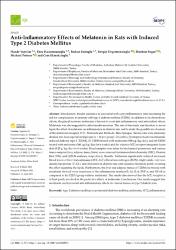| dc.contributor.author | Yapislar, Hande | |
| dc.contributor.author | Haciosmanoglu, Ebru | |
| dc.contributor.author | Sarioglu, Turkan | |
| dc.contributor.author | Degirmencioglu, Sevgin | |
| dc.contributor.author | Sogut, Ibrahim | |
| dc.contributor.author | Poteser, Michael | |
| dc.contributor.author | Ekmekcioglu, Cem | |
| dc.date.accessioned | 2022-12-05T09:45:24Z | |
| dc.date.available | 2022-12-05T09:45:24Z | |
| dc.date.issued | 2022 | en_US |
| dc.identifier.citation | Yapislar, H., Haciosmanoglu, E., Sarioglu, T., Degirmencioglu, S., Sogut, I., Poteser, M., & Ekmekcioglu, C. (2022). Anti-Inflammatory Effects of Melatonin in Rats with Induced Type 2 Diabetes Mellitus. Life, 12(4), 574. | en_US |
| dc.identifier.issn | 2075-1729 | |
| dc.identifier.uri | https://doi.org/10.3390/life12040574 | |
| dc.identifier.uri | https://hdl.handle.net/20.500.12294/3075 | |
| dc.description.abstract | Introduction: Insulin resistance is associated with a pro-inflammatory state increasing the risk for complications in patients with type 2 diabetes mellitus (T2DM). In addition to its chronobi-otic effects, the pineal hormone melatonin is known to exert anti-inflammatory and antioxidant ef-fects. Melatonin was also suggested to affect insulin secretion. The aim of this study was therefore to investigate the effect of melatonin on inflammation in diabetic rats and to study the possible involvement of the melatonin receptor, MT2. Materials and Methods: Male Sprague Dawley rats were randomly divided into four experimental groups (n = 10 per group): (1) control, (2) strepto-zotocin/nicotinamide induced diabetes type 2 (T2DM), (3) T2DM treated with melatonin (500 µg/kg/day), and (4) T2DM treated with melatonin (500 µg/kg/day for 6 weeks) and the selective MT2 receptor antagonist luzindole (0.25 g/kg/day for 6 weeks). Blood samples were taken for biochemical parameters and various tissue samples (liver, adipose tissue, brain) were removed for im-munohistochemistry (IHC), Western blot (WB), and Q-PCR analyses, respectively. Results: Melato-nin significantly reduced increased blood levels of liver transaminases (AST, ALT), blood urea ni-trogen (BUN), triglyceride, very low-density lipoprotein (VLDL), and cholesterol in diabetic rats with luzindole treatment partly reversing this effect regarding the lipids. Furthermore, the liver and adipose tissues of T2DM rats treated with melatonin showed lower expression of the inflammatory markers IL-1β, IL-6, TNF-α, and NF-κB as compared to the T2DM group without melatonin. The results also showed that the MT2 receptor is at least partly involved in the protective effects of mel-atonin. Conclusions: Our results suggest that melatonin exerts relevant anti-inflammatory effects on various tissues in type 2 diabetic rats. © 2022 by the authors. Licensee MDPI, Basel, Switzerland. | en_US |
| dc.language.iso | eng | en_US |
| dc.publisher | MDPI | en_US |
| dc.relation.ispartof | Life | en_US |
| dc.identifier.doi | 10.3390/life12040574 | en_US |
| dc.rights | info:eu-repo/semantics/openAccess | en_US |
| dc.subject | Experimental Diabetes Mellitus | en_US |
| dc.subject | Inflammation | en_US |
| dc.subject | Melatonin | en_US |
| dc.subject | MT2 | en_US |
| dc.subject | Type 2 Diabetes Mellitus | en_US |
| dc.title | Anti-Inflammatory Effects of Melatonin in Rats with Induced Type 2 Diabetes Mellitus | en_US |
| dc.type | article | en_US |
| dc.department | Tıp Fakültesi, Temel Tıp Bilimleri | en_US |
| dc.authorid | 0000-0001-7243-3671 | en_US |
| dc.identifier.volume | 12 | en_US |
| dc.identifier.issue | 4 | en_US |
| dc.relation.publicationcategory | Makale - Uluslararası Hakemli Dergi - Kurum Öğretim Elemanı | en_US |
| dc.institutionauthor | Degirmencioglu, Sevgin | |
| dc.authorwosid | M-4010-2017 | en_US |
| dc.authorscopusid | 25632114400 | en_US |
| dc.identifier.wosquality | Q2 | en_US |
| dc.identifier.wos | WOS:000786783500001 | en_US |
| dc.identifier.scopus | 2-s2.0-85128991847 | en_US |


















